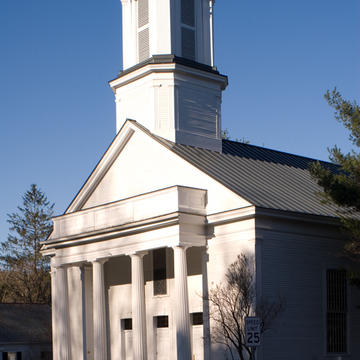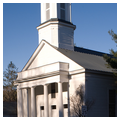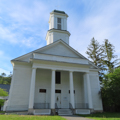This is the earliest and most elaborate of four Windsor County churches—Sharon (1837), Barnard (1845), and Pomfret (WS17)— attributable to Eli Buch of Barnard. It is also the one most closely based upon a church design published in Asher Benjamin's The Practice of Architecture (1833). The building's facade has narrow fluted pilasters that carry a full entablature beneath an articulated pediment. A projecting fluted Doric portico topped by a paneled balustrade frames triple doorways set behind a recessed porch. The fluting is repeated on the two-stage octagonal tower, where a short clapboarded base supports a belfry with slim Ionic columns set between angled corner piers and carrying a low dome. While not capturing Benjamin's more substantial Greek proportions or his literal Greek motifs, Buch does repeat the essential features of the design and the inherent logic of its organization. This church seems to have established a pattern for Buch to work with primarily Universalist congregations, though never again with a budget as generous as the one provided by populous and prosperous Woodstock.
You are here
Universalist Church
If SAH Archipedia has been useful to you, please consider supporting it.
SAH Archipedia tells the story of the United States through its buildings, landscapes, and cities. This freely available resource empowers the public with authoritative knowledge that deepens their understanding and appreciation of the built environment. But the Society of Architectural Historians, which created SAH Archipedia with University of Virginia Press, needs your support to maintain the high-caliber research, writing, photography, cartography, editing, design, and programming that make SAH Archipedia a trusted online resource available to all who value the history of place, heritage tourism, and learning.


















